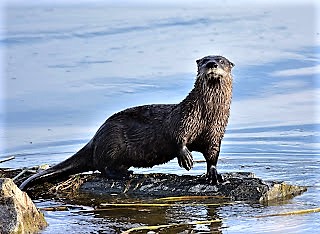State taking comment on Flandreau Santee Sioux river otter rescue

South Dakota proposes to drop protection of otters, a tribal cultural icon. COURTESY / Tom Koerner/USFWS
PIERRE — South Dakota Game, Fish and Parks (GFP) Commission is asking the public to offer testimony at a call-in teleconference May 7 on reopening hunting and trapping of the protected river otter, as well as on other topics.
The Flandreau Santee Sioux Tribe is responsible for bringing back the vanished population of this playful semi-aquatic mammal to the South Dakota in 1998-2000, after it was wiped out. Now the commission wants to take it off the state list of threatened species.
Formally known as the North American river otter (Lontra canadensis), this furry weasel-like critter with whiskers was historically widespread across the continent, including in South Dakota. However, habitat degradation and unregulated take during the early 20th Century drastically reduced numbers, prompting its inclusion in 1978 on the state’s first roster of endangered and threatened animals.
The Flandreau Santee Sioux Tribe released 34 river otters along the Big Sioux River on tribal grounds in Moody County as part of a cultural goal to restore a native species to tribal Lands.
By 2015, sightings reported they had spread to other eastern state waterways — the Vermillion and James River drainages, Jorgenson River, Little Minnesota River, Whetstone River, Yellow Bank River, Jim Creek-Big Slough and the Missouri River downstream from Pierre.
The GFP Department credits “the tribal reintroduction, along with natural recolonization from other areas,” for a growing river otter population in eastern South Dakota.”
In the western state, LaCreek National Wildlife Reserve, southeast of Martin, reintroduced and radio-chipped two river otters in 2013; the male’s chip either failed, or he left the area or died. The female reproduced, had one cub and then died of natural cause. The last confirmed sighting there was made by a trail camera in 2018.
The GFP department recommends the commission remove protection because criteria established in the state’s 2015 five-year recovery plan have been met. To wit: Verified reports of reproduction are documented in three of the five, or 60 percent, of the basins and in 40 percent of the sub-basins within the plan area.
The Prairie Hills Chapter of the National Audubon Society says it wants the river otter to be reintroduced in more of western South Dakota before it is delisted. Feasibility studies for further reintroductions have been done at least as far back as 2003.
The live-stream meeting, being coordinated at the Custer State Park Barn, begins at 1 p.m. CT, or 12 p.m. MT at www.sd.net/ and www.sd.net/remote1/. It offers an online-only hearing due to protocols for reducing health risks during the Covid-19 pandemic.
Comments have been scheduled to begin at 2 p.m. CT, or 1 p.m. MT — with three-minute time slots available. The conference call number available for the public starting at 2 p.m. CT, or 1 p.m. MT is 1-866-410-8397, with a Conference Code of 5451787643#.
(Contact Tall Nauman at talli.nauman@gmail.com)
